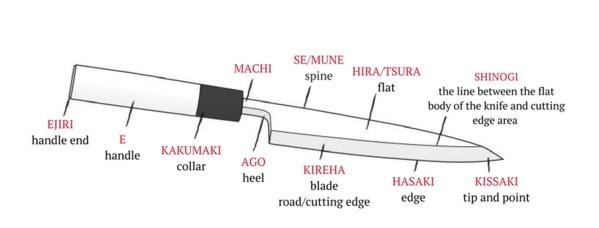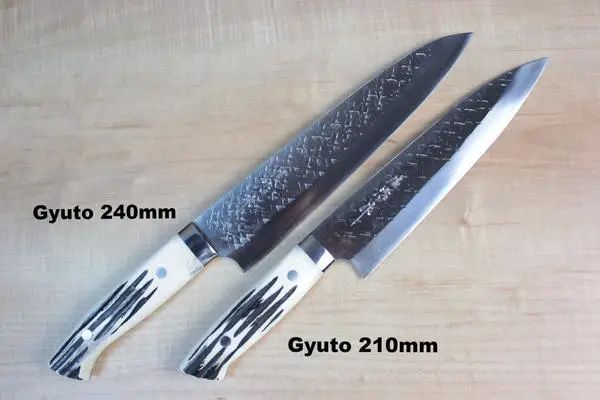A 210mm Gyuto is a chef’s knife for home cooks with a lightweight profile, whereas the 240mm Gyuto is slightly heavier but better for cutting more food volume. Choosing between 210 or 240mm Gyuto knife ultimately depends on your skills as a cook, the food you want to cut, and how much you’re willing to spend, among other things.
Learn here about the differences between 210 vs 240 Gyuto knife and how their size and weight can impact your performance as a cook.
Difference Between 210 and 240mm Gyuto Knife
| Subject | 210mm Gyuto Knife | 240mm Gyuto Knife |
| Space Required | Small Home Kitchen Areas | Bigger Kitchen Areas & Restaurants with Large Working Spaces |
| User Type | Beginners | Professionals |
| User Height | <5.9 ft | >5.9 ft |
| Cutting Board Size | Small & Medium | Medium & Large |
| Ingredients to Cut | Small food, vegetables, fruits & herbs. | Large food, vegetables, fruits & more. |
| Weight | 5.0 ounces (144g) – 9.7 ounces (276g). | 5.8 ounces (166g) and 10.4 ounces (294g). |
| Grip | Combo Grip | Pinch Grip |
| Price | ≈$85 to $321.66 | ≈$138 to $2,117.32 |
210 Vs 240mm Gyuto Knives: What Are the Key Differences?
The size of a Gyuto knife can heavily affect your cooking experience. A 210mm is great for small jobs, whereas 240mm is more suitable for heavy workloads. But that’s not the only difference between these two knife sizes. Learn all about every element that sets these two knives apart here.
1. Space Required
210mm can adjust to small places. If you have a small kitchen, the 210mm Gyuto kitchen knife is ideal because you won’t bump your elbow into things while cutting. Furthermore, this knife can also adapt to smaller cutting boards, which are a must in confined spaces.
Also, if you enjoy preparing food with your partner, family, or friends, a small 210mm knife will allow you to work shoulder to shoulder.
240mm generally needs more space. A larger 240mm Gyuto knife means you’ll need more space to chop or slice food with a full push-forward cutting motion. If you use these knives in a smaller area, you won’t get to use the entire length of the cutting edge. You’ll most likely hit your elbow against the fridge or anything behind you.
Plus, you will also need the extra space to fit a large cutting board to support a larger 240mm blade. Unlike the 210mm, a 240mm Gyuto is more suitable for restaurants or larger kitchens with a spacious working area.
2. User Skill
210mm is generally better for beginners that mostly use the blade tip for cutting. If you prefer tip cutting instead of cutting techniques like rock chopping, you won’t need the extra length and blade height of the 240mm knife. Go with a shorter 210mm Gyuto for an entry-level home cook.
240mm is mostly used by the pros, that know how to use the full extent of a larger blade. This knife is good for home use but it’s much more beneficial for professional jobs like restaurants. The Gyuto chef knives of this size can cut larger vegetables and more volume at a faster pace. Additionally, you can use the 240mm to cut more ingredients, fruits like watermelons, or larger meat pieces.
3. User Height
210mm is good for people below 5.9 ft. If you’re below this height, the 210mm knife is for you. It’s a smaller chef’s knife that won’t feel awkward once you get a hold of it and start cutting.
240mm is good for people over 6.0 ft. For people on the taller side, a larger knife set is always the go-to choice. As an extension of your arm, it will take a short amount of time for you to get used to the Gyuto’s size.
Tip: Use the Forearm Test to help you find the right knife size. Put the knife over your forearm and measure it from the tip to the blade’s heel, which should be at wrist level. Pick the Gyuto knife that most matches the size of your forearm.
Check out the below video by Chef Cristian Feher, he has explained how to do the forearm test.
4. Cutting Board
A 210mm Gyuto can do with boards of all sizes due to its smaller blade length. You can use it to cut veggies using a push-forward motion and remain within the limits of the board. Since this knife is better for cutting one item at a time, there’s no need to have a considerably large cutting board.
240mm Gyuto knives work better with medium-sized and large cutting boards. Professionals use knives of this size to cut more volume and larger food like meat, which is why a bigger cutting board is a must. Otherwise, you would run out of space to use the full length of the blade.
5. Ingredients to Cut
210mm knives are used to cut smaller food. Use it to prepare onions, carrots, celery sticks, and tomatoes. This knife is also suitable for cutting smaller pieces of boneless meats and small to medium-sized fish. Additionally, the 210mm Gyuto can cut herbs like basil, cilantro, and dill.
Overall, Gyuto knives of this size are excellent for home cooking, where you don’t necessarily deal with high food portions.
The 240mm knives are better for cutting larger food. Use this knife to cut a bunch of celery, multiple onions, or a package of carrots at once. You can also use a 240mm Gyuto to squash down large stuff like kale or cutting watermelon, pumpkins, and cabbage. Lastly, larger meat chunks won’t be a problem to chop down into smaller bits either.
Due to its capacity to cut more food, the 240mm knife is better for professional chefs.
6. Weight
The weight of a 210mm Gyuto knife can be between 5.0 ounces (144g) and 9.7 ounces (276g). With this weight, the 210mm is better for back-and-forth cutting motions. Your hands won’t get tired as quickly, and beginners can use it for long periods to practice.
A 240mm Gyuto knife weighs between 5.8 ounces (166g) and 10.4 ounces (294g). It doesn’t seem like much of a difference, but the extra weight and added length of the blade are significant. While cutting, a heavier Gyuto knife provides more stability if you prefer to cut in rock chopping motions. Also, you can let the heavier blades do some of the jobs for you.
7. Grip
Use a combo grip for 210mm knives. This technique is a combination of the regular grip with the pinch grip. While it’s not the most ergonomic option, this grip is perfect for a smaller Gyuto knife. You receive limited control over the knife, but it’s still good enough for most slicing tasks.
A pinch grip is more suitable for 240mm Gyuto knives. This grip provides great control over the length of the blade, and it feels natural. If the ingredient you’re cutting twists in an awkward position, the pinch grip helps you maintain proper control of the knife.
8. Price
210mm Gyuto knives are available within the $85 and $321.66 range. The Tojiro DP Gyuto is an affordable $85.95 210mm knife with a stainless steel blade. Since it has an even edge, both right and left-handed chefs can use it. For $321.66, you can buy a Kagekiyo Shiro 210 Wagyuto. This one sports a sleek design with a carbon steel blade for more accuracy and control.
The price range of the 240mm Gyuto varies between $138 and $2,117.32. At the lowest price, you can find Japanese knives like the Okimoto Mori 240mm Gyuto. For $2,117.32, you have access to a high-end Nenohi Honyaki 240mm Gyuto with three silver rings and an ebony handle.
Read also: Santoku Knife for Slicing, Chopping, and Dicing
How to Use a Gyuto Knife?
Use the Gyuto knife by holding it with your dominant hand in a pinch grip. This technique places your index and thumb right at the blade’s point of balance for more control.
Then, use your non-dominant hand to hold the food in place over the cutting board. You can use the third knuckle of your middle finger against the side of the blade for guidance. With the rest of your fingers, form a claw-like shape behind your middle finger to grab the ingredients.
Pro Tip: Don’t hold the Gyuto knife by the handle, at least not entirely. If you do, the knife blade may lean forward due to its weight, and it won’t feel balanced. Your index and thumb must be slightly past the heel and your middle finger just behind the heel. Your ring and little finger should be over the neck and collar, respectively.

So, What Size Gyuto Is Best?
Go with a 210mm Gyuto knife if you prepare food in the comfort of your home kitchen. This knife is great for small cutting tasks to satisfy a household of four or fewer members. You won’t need a lot of space, and the knife can cut, slice, chop, and dice just fine. A knife of this size is also more affordable, meaning you can use it to practice as you become a better chef.
If you work with high food volume in a big household or a large restaurant, the 240mm Gyuto is the better choice. While using this knife, you can chop food faster by piling veggies or meat over the cutting board. That’s why it appeals mostly to serious amateurs and professional cooks.

